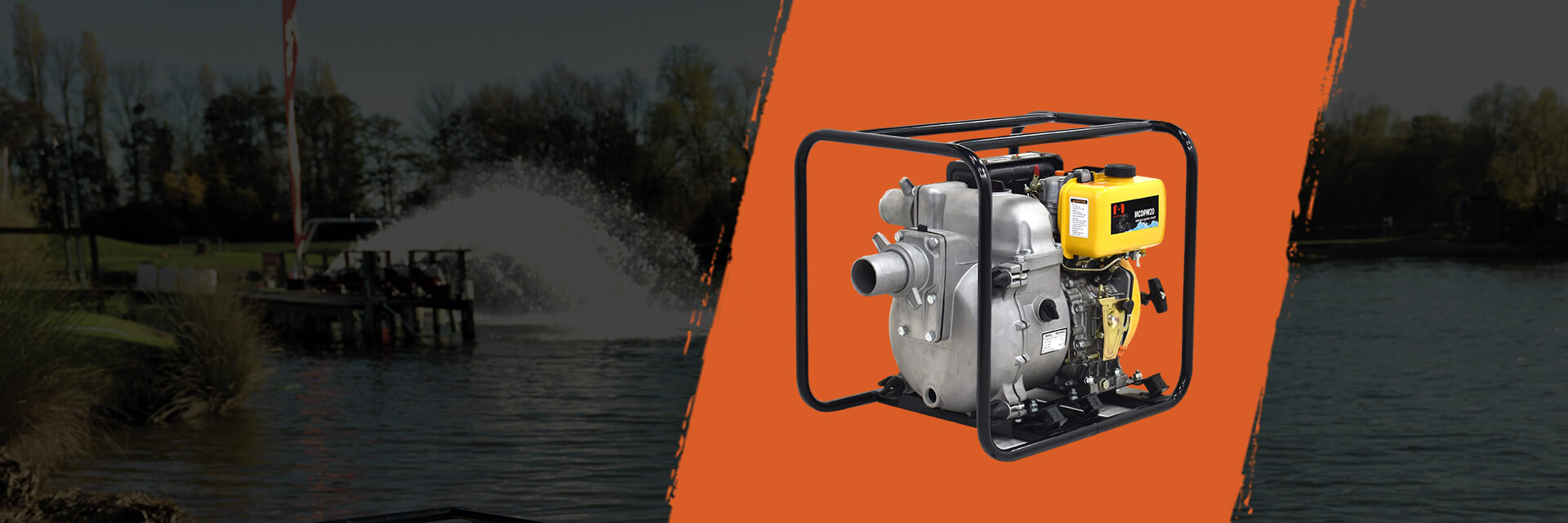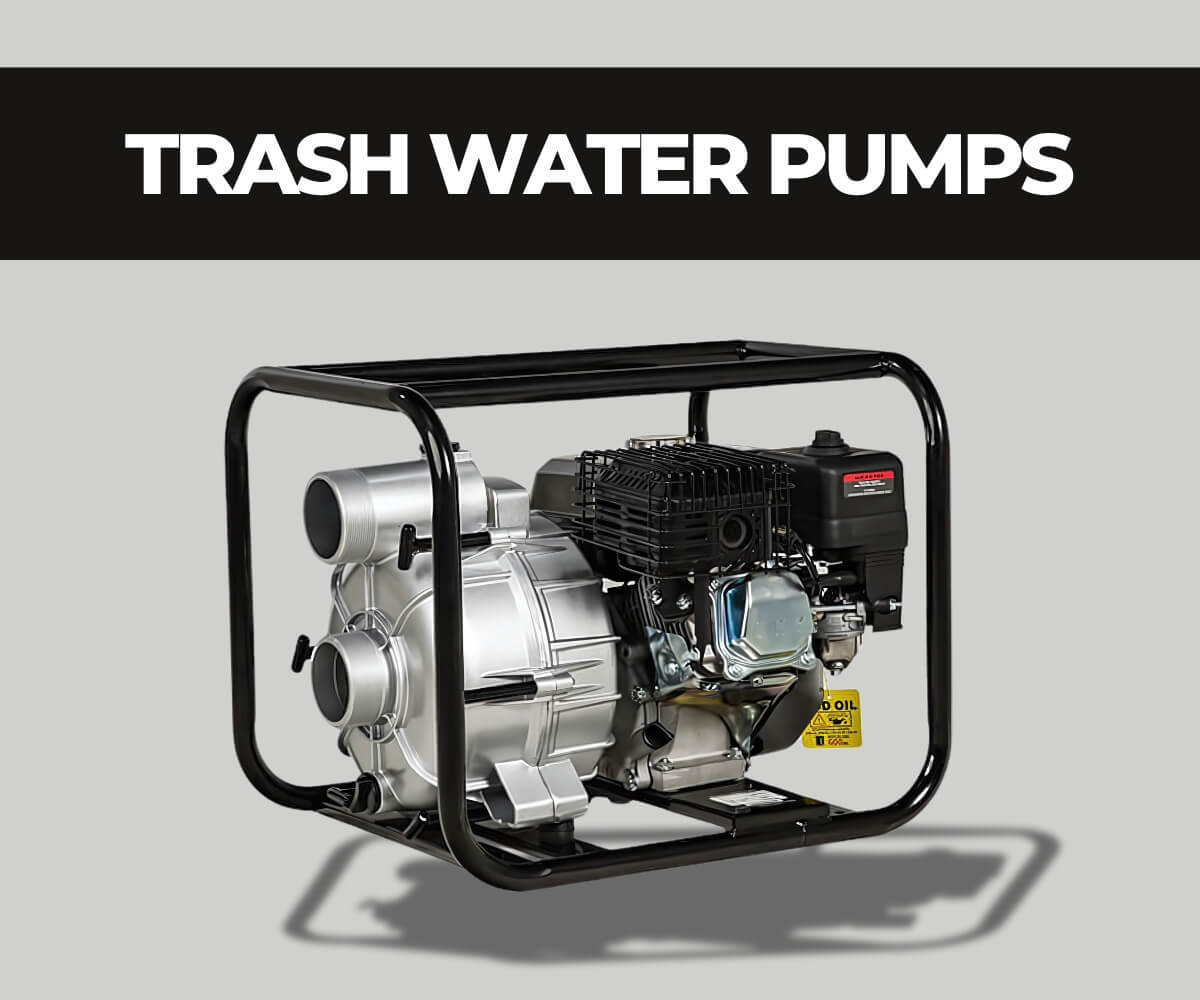
trash water pumps
MATCHUP, a Chinese OEM, offers all kinds of trash water pumps at wholesale prices. Contact us today for more details. Let’s dive in!
OEM/ODM water pump manufacturers
trash water pump manufacturers and suppliers
Trash water pumps are tough machines built with wide openings and strong impellers to move messy water without clogging or damage. Unlike regular clean water pumps, trash pumps efficiently move water containing solids.
Trash water pumps come in various configurations, including self-priming, submersible, trailer-mounted, and PTO-driven models, each suited to different applications and environments. They are typically powered by gas, diesel, or electric motors, with options to suit various power needs and preferences.


professional water pumps manufacturer
Applications of trash water pumps
Trash pumps play a vital role in many industries, helping people deal with stubborn wastewater in a variety of situations. Whether it’s clearing floodwaters or draining sludge pits, these pumps are designed to ensure that water flows freely. Let’s explore the real-life application scenarios of trash pumps in different industries.
Construction and mining
On construction and mining sites, standing water can quickly become a problem. Heavy rains can cause ditches to flood with muddy water, and potholes can also fill with water carrying sand, rocks, and mud. Trash pumps are the go-to solution, easily handling water filled with debris, avoiding delays and ensuring that work can proceed smoothly. They keep the site clean and safe, ensuring uninterrupted continuous operation.
Public works
Trash pumps are essential for maintaining public works infrastructure and responding to natural disasters. They help to unclog sewage and stormwater systems during heavy rains and move standing water away from flood-prone areas to prevent property damage and ensure safety. In emergency situations, these pumps also ensure that water in critical systems flows efficiently.
Factories
In the manufacturing and processing industries, trash pumps are used to move wastewater mixed with oil, chemicals or other industrial liquids. They handle wastewater and thick liquids, keeping them clean and ensuring uninterrupted production without the risk of blockages or flooding.
Agriculture
Trash pumps assist with irrigation and drainage on farms. They move water containing mud, plant debris or debris to prevent pipes from clogging and fields from flooding. By managing water resources effectively, these pumps support healthy crop growth and protect farmland from damage.
Emergency response
During floods and natural disasters, trash pumps are essential for quick cleanup. They can remove large amounts of sewage mixed with debris such as leaves and mud, helping to protect homes and businesses and speed community recovery.
trash water pump buying guide
When heavy rain flooded a remote construction site in the countryside, work came to a halt. Muddy water filled the foundation trenches, mixed with leaves, sand, and small stones. Regular water pumps clogged in minutes. But one machine kept things moving — a trash water pump. Rugged and reliable, it quickly cleared the sludge, saved the schedule, and got the project back on track.

What is a trash water pump?
A trash water pump is designed to handle water mixed with solid debris, mud, sediment, and other waste that is too large or solid to be handled by a standard centrifugal pump. A trash water pump’s capacity to handle different sizes and amounts of debris depends on its design and features.
These pumps use a powerful engine or motor to spin an impeller inside. As the impeller turns, it creates a vacuum that pulls in dirty water. Thanks to wide pathways and solid construction, the pump keeps running even with debris in the mix.
Trash water pumps are used in various applications such as construction sites, mining operations, agricultural settings, sewage systems, flood control, and wastewater treatment plants.
Key features to consider before purchasing a trash water pump
With so many options available, choosing the right trash water pump can be overwhelming. Making an informed decision means considering more than just the price. A smart purchase requires understanding the specific needs of the job at hand.
Don’t worry! MATCHUP will guide you through everything you need to know. To make sure you choose the best trash water pump for your unique requirements and applications, you must consider a number of crucial features. Here are some critical features to keep in mind:
Types of trash water pumps
Trash water pumps come in many types, each with unique features and benefits. Selecting the ideal pump for your needs is easier when you understand the differences. A few common types are:
Self-priming trash water pumps
Self-priming trash water pumps automatically remove air from the suction line and create a vacuum without manual priming. They are ideal where frequent priming would be inconvenient or when the pump is placed above the water source. These pumps are commonly used on construction sites, wastewater treatment plants, and in industrial applications.
Submersible trash water pumps
Designed to be fully submerged in the liquid, submersible trash water pumps handle water with solids effectively without risk of cavitation. They are often used to pump sewage, clear flooded areas, and drain basements or tunnels. Their compact and portable design makes them suitable for confined spaces and remote locations.
Trailer-mounted trash water pumps
Mounted on trailers or skids for easy transport, these pumps have wheels or tow hitches to attach to vehicles for quick deployment. They are widely used in construction projects, municipal emergency response, and other situations where mobility and versatility are essential.
Engine options
Gas pumps are powered by gasoline, diesel, or electric motors, each with their own advantages.
- Gasoline pumps: Gasoline pumps are powered by gasoline and do not require an electrical outlet. Known for their portability and ease of use, they are lightweight and have a high strength-to-weight ratio for mobile applications.
- Diesel pumps: Diesel engines have more torque, longer life, and are more fuel efficient. They are economical, require less maintenance, and are suitable for large-scale, heavy-duty operations, making them ideal for industrial or emergency flooding situations.
- Electric pumps: These pumps are powered by electricity. Electric pumps are quiet and emission-free, making them ideal for indoor or emission-restricted areas. However, they rely on an electrical power source and need to be properly grounded to prevent hazards.
If you choose a gasoline or diesel pump, also consider fuel efficiency and run time to reduce operating costs.
Solids size and types the pump can handle
Trash pumps can handle different types of solids, from sand and mud to small rocks and leaves. Consider the maximum length of solids the pump can handle without stopping, usually in inches, and select a pump that fits the solids handling capacity of your application.
Real-world example: If you are pumping water from a construction site that has a mix of mud, sand, and small rocks, then a trash pump with a larger opening would be ideal. If you are primarily handling leaves and light debris, a semi-trailer trash pump with a smaller opening would meet your needs.
Flow rate (How much water needs to be moved)
The flow rate is how much water the pump can move in each time, usually measured in gallons per minute (GPM) or liters per minute (LPM). The higher the flow rate, the faster the pump can remove water. Consider factors such as the drainage area’s size or the water infiltration rate. To ensure efficient operation, the flow rate must match or exceed the volume of water and debris you need to move.
For flood cleanup in a small area, you might only need a pump with a moderate flow rate (around 100-200 GPM). But for larger areas like construction sites or commercial applications, you’ll need a pump with a higher flow rate (500 GPM or more) to handle the volume of water.
Head pressure and suction lift
The head is the height or distance the pump can push water. This is crucial if you need to move water vertically (e.g., to drain a pit or pump water up a hill) or horizontally (e.g., moving water across a large area). The higher the head, the more powerful the pump needs to be.
Determine the maximum height at which the pump can lift water from its source (suction lift). This is especially important if you are pumping from a reservoir, pond, or underground source. Make sure the pump’s suction lift capacity meets or exceeds your needs.
Portability and size
Depending on your application, you may need a lightweight, portable pump for easy transport and maneuverability. Some jobs require frequent transport or use in confined areas like basements or small utility rooms. When evaluating portability, consider weight, handle design, and wheel options.
Warranty and support
Check the availability of customer service and the manufacturer’s warranty. A thorough warranty and prompt customer service can provide peace of mind and help address any issues or concerns.
For extra protection, consider service plans or extended warranties. While these may add upfront costs, they can offer valuable support and cost savings in case of unexpected problems or repairs.
Budget considerations
When considering your budget for a trash water pump, it’s crucial to balance upfront costs with long-term value and performance. Consider the total cost of the pump’s life, including maintenance, repair, and operating expenses. High-quality pumps may have higher upfront costs but save money in the long-term due to durability, dependability, and fuel efficiency.
First, determine your budget and look for options within your price range. Compare prices from multiple manufacturers and suppliers to find a pump that offers the features and performance you need at a reasonable cost.
Factor in ongoing costs such as fuel or power consumption, maintenance, and repairs. Choose a pump with good fuel or energy efficiency to lower operating costs. Also, consider ease of maintenance and availability of replacement parts and service support to reduce downtime and expenses.
Conclusion: Making the right choice for your trash water pump needs
In this article, we’ve covered everything you need to know about trash water pumps. These pumps are used across many industries, including construction, public works, agriculture, and emergency response. Whether removing water from construction sites, managing sewage, or responding to floods, trash water pumps are built to get the job done.
Taking the time to choose the right one based on your specific needs will make all the difference. Keep your pump well-maintained and work with a trusted supplier to ensure you get the best product for your job. By doing so, you’ll keep your operations running efficiently, no matter how tough the water-moving task may be.
about trash water pumps, people also want to know:
Steps for inspecting, cleaning, and unclogging your pump
Inspect the pump for visible damage such as cracks, loose parts, or leaks. Ensure the intake and discharge openings are clear.
Clean the pump by removing dirt, debris, or sludge buildup. Rinse thoroughly with water to prevent clogging and maintain efficiency.
Unclog the pump if performance drops. Remove debris from the intake, impeller, or hoses using a brush or garden hose.
Replacing worn parts
Parts like seals, gaskets, or impellers wear down over time. Replace these before failure to avoid leaks or reduced performance. Regularly check these components and replace them if damaged or inefficient.
Storage tips to protect your pump
Proper storage preserves your pump during off-seasons or long breaks:
- Drain all water to prevent rust or freezing.
- Store in a dry, clean area to avoid moisture buildup and corrosion.
- Keep out of direct sunlight and extreme temperatures; a covered shed or garage is ideal.
Quick fixes for common problems
- Pump won’t start: Check the power source and ensure fuel is fresh and tank full (for gas pumps). Inspect air filters and fuel lines for clogs.
- Low water flow: Clean clogged intake and inspect the impeller for damage.
- Leaking water: Leaks often occur around seals or gaskets. Replace worn seals or gaskets promptly.



